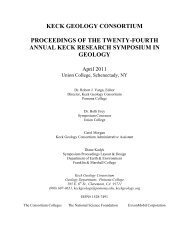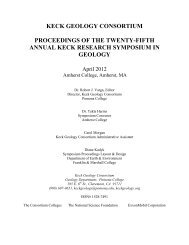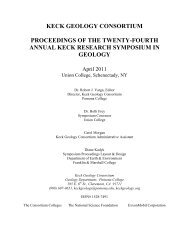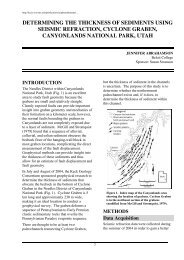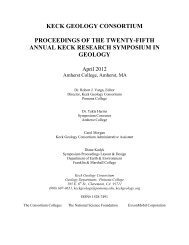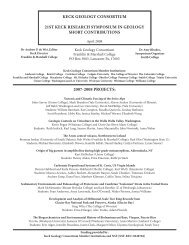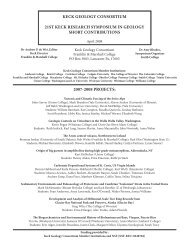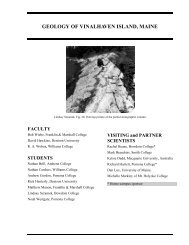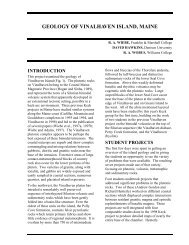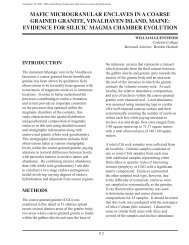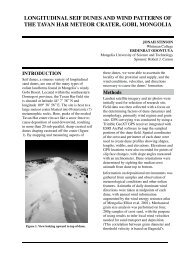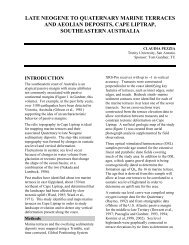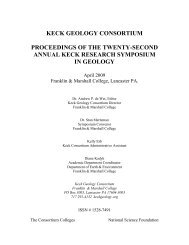volcanic stratigraphy and petrology of the northern snaefellsnes rift ...
volcanic stratigraphy and petrology of the northern snaefellsnes rift ...
volcanic stratigraphy and petrology of the northern snaefellsnes rift ...
Create successful ePaper yourself
Turn your PDF publications into a flip-book with our unique Google optimized e-Paper software.
http://keck.wooster.edu/publications/eighteenthannual…<br />
VOLCANIC STRATIGRAPHY AND PETROLOGY OF THE<br />
NORTHERN SNAEFELLSNES RIFT, SOUTHERN<br />
LAXÁRDALSFJÖLL, ICELAND<br />
LEBN SCHUYLER<br />
Whitman College<br />
Sponsor: John Winter<br />
INTRODUCTION<br />
Icel<strong>and</strong> is exposed above sea level due to thick<br />
crust produced by <strong>the</strong> interaction between a<br />
stationary mantle plume <strong>and</strong> <strong>the</strong> Mid-Atlantic<br />
Ridge. The ridge d<strong>rift</strong>s westward with respect<br />
to <strong>the</strong> plume <strong>and</strong> <strong>the</strong>n periodically jumps to<br />
<strong>the</strong> east, ab<strong>and</strong>oning <strong>the</strong> old ridge to re-center<br />
over <strong>the</strong> plume. The most recent jump<br />
occurred at ~7 Ma when <strong>the</strong> ridge ab<strong>and</strong>oned<br />
<strong>the</strong> Snaefellsnes <strong>rift</strong> <strong>and</strong> jumped 100-200 km<br />
eastward to its present location (Hardarson et<br />
al., 1997).<br />
The <strong>volcanic</strong> rocks <strong>of</strong> <strong>the</strong> sou<strong>the</strong>rn<br />
Laxardalsfjoll range in <strong>the</strong> nor<strong>the</strong>rn<br />
Snaefellsnes <strong>rift</strong> are predominantly Tertiary<br />
tholeiitic basalt flows. Major <strong>and</strong> trace<br />
element data for <strong>the</strong>se basalts, when compared<br />
to typical primary N-MORB, indicate <strong>the</strong>y are<br />
evolved. This reflects fractional<br />
crystallization in a shallow magma chamber,<br />
<strong>and</strong> enrichment in incompatible trace elements<br />
due to interaction with <strong>the</strong> Icel<strong>and</strong>ic plume.<br />
Near <strong>the</strong> middle <strong>of</strong> <strong>the</strong> sequence are felsic<br />
<strong>volcanic</strong>s that include a rhyolite, a coarsely<br />
porphyritic <strong>and</strong>esite, <strong>and</strong> several tuffs (Fig. 1,<br />
2). Samples were analyzed petrographically<br />
<strong>and</strong> geochemically to evaluate <strong>the</strong> generation<br />
<strong>and</strong> evolution <strong>of</strong> <strong>the</strong>se <strong>volcanic</strong>s allowing for a<br />
better underst<strong>and</strong>ing <strong>of</strong> magmatic processes<br />
involving <strong>the</strong> interaction between a mid-ocean<br />
ridge nearing ab<strong>and</strong>onment <strong>and</strong> a mantle<br />
plume.<br />
Field Area<br />
Laxardalsfjoll (Fig. 1) is a NW-SE trending<br />
ridge at <strong>the</strong> sou<strong>the</strong>rn end <strong>of</strong> <strong>the</strong> Skagi<br />
Peninsula in nor<strong>the</strong>rn Icel<strong>and</strong>. This field area<br />
was chosen due to <strong>the</strong> presence <strong>of</strong><br />
intermediate <strong>and</strong> silicic units (Fig. 3), which<br />
are unusual in Icel<strong>and</strong>. The lower 200 m <strong>of</strong><br />
exposure are basalt flows ranging from 3-12 m<br />
thick (Fig. 1, 2). These relatively homogenous<br />
lavas are overlain by a ~60 m <strong>and</strong>esite that<br />
contains plagioclase phenocrysts up to several<br />
centimeters in diameter <strong>and</strong> has been named<br />
Figure 1. Panoramic view <strong>of</strong> <strong>the</strong> study area looking NW. Tb indicates Tertiary basalt, pink Tr is rhyolite,<br />
purple Ta is Strjugsskard <strong>and</strong>esite, <strong>and</strong> pink Trd is rhyolite dikes. Faults indicated by black lines. All faults<br />
are normal faults (some distorted by perspective). (Photos by Keegan Schmidt)<br />
92
http://keck.wooster.edu/publications/eighteenthannual…<br />
Figure 2. Geologic map <strong>of</strong> sou<strong>the</strong>rn<br />
Laxaralsfjoll, NE Icel<strong>and</strong>.<br />
<strong>the</strong> Strjugsskard <strong>and</strong>esite (cf. Adzima, this<br />
volume). This unit is discontinuously overlain<br />
by tuffs, a tuffaceous breccia, <strong>and</strong> a few thin<br />
basaltic <strong>and</strong>esite lavas. Up section is a 30-80<br />
m thick flow-b<strong>and</strong>ed rhyolite. Above <strong>the</strong><br />
rhyolite is a discontinuous b<strong>and</strong> <strong>of</strong> tuffs, some<br />
containing large plagioclase crystal fragments.<br />
The upper 200 m <strong>of</strong> <strong>the</strong> ridge is ano<strong>the</strong>r thick<br />
section <strong>of</strong> basalt lavas.<br />
Several major NW-SE trending normal faults<br />
are found in <strong>the</strong> field area (Fig. 2), as are<br />
numerous small basaltic dikes, most <strong>of</strong> which<br />
were too small to map. A few large rhyolite<br />
dikes also crop out above <strong>and</strong> below <strong>the</strong> flowb<strong>and</strong>ed<br />
rhyolite unit. The rhyolite thickens<br />
near <strong>the</strong> center <strong>of</strong> <strong>the</strong> field area <strong>and</strong><br />
relationships become more complex. One<br />
particularly complex faulted <strong>and</strong> tilted block<br />
contains thick tuffs, <strong>and</strong>esite, dacite, <strong>and</strong><br />
rhyolite that may be at or near a center for <strong>the</strong><br />
silicic eruptions.<br />
Petrography<br />
In h<strong>and</strong> specimen <strong>the</strong> basalts exhibit an<br />
aphanitic groundmass with only a few<br />
phenocrysts <strong>and</strong> vesicles. Thin sections reveal<br />
textures that are typically intergranular to<br />
intersertal. The groundmass is composed <strong>of</strong><br />
predominately felty, but occasionally<br />
trachytic, plagioclase laths, clinopyroxene<br />
microlites, iron-titanium oxides, <strong>and</strong> glass<br />
(typically altered to brown palagonite).<br />
Phenocrysts are sparse: mostly 1-2 mm<br />
plagioclase <strong>and</strong> augite.<br />
The plagioclase phyric <strong>and</strong>esitic unit<br />
(Strjugsskard <strong>and</strong>esite) contains up to 35%<br />
euhedral plagioclase phenocrysts ranging up to<br />
several centimeters in diameter. The<br />
groundmass is generally dark gray to purple<br />
near <strong>the</strong> bottom <strong>of</strong> <strong>the</strong> flow, becoming more<br />
red toward <strong>the</strong> top. Flow b<strong>and</strong>ing (interpreted<br />
as commingling) is locally prominent, <strong>and</strong><br />
manifested in thin section by variation in<br />
crystal size <strong>and</strong> glass concentration. The<br />
groundmass contains small plagioclase laths<br />
with augite, iron-titanium oxides, some<br />
olivine, <strong>and</strong> glass. Plagioclase phenocrysts<br />
exhibit some oscillatory zoning, <strong>and</strong> several<br />
disequilibrium textures including sieve,<br />
resorption, rounded edges, <strong>and</strong> embayed<br />
margins.<br />
Rhyolites in <strong>the</strong> field are usually dark grey to<br />
purple <strong>and</strong> highly flow b<strong>and</strong>ed, although some<br />
isolated outcrops contain porphyritic obsidian.<br />
Rhyolite dikes are generally light colored <strong>and</strong><br />
very fine-grained. Alteration <strong>and</strong> <strong>the</strong> small<br />
grain size make mineral identification very<br />
difficult in thin section. A few small<br />
plagioclase laths are visible, occasionally with<br />
inclusions <strong>of</strong> clinopyroxene <strong>and</strong> zircon.<br />
Geochemistry<br />
Many Harker-type diagrams exhibit smooth<br />
trends suggesting that all <strong>the</strong> lavas are<br />
genetically related. Samples span a wide range<br />
93
http://keck.wooster.edu/publications/eighteenthannual…<br />
<strong>of</strong> composition, from basalts to rhyolite (Fig.<br />
3). Most <strong>of</strong> <strong>the</strong> basalts <strong>and</strong> basaltic <strong>and</strong>esites<br />
conform to a tholeiitic AFM trend. Most<br />
incompatible element concentrations in <strong>the</strong><br />
basalts are high, even higher than in typical E-<br />
MORBS. The basalts also show an average<br />
Mg# <strong>of</strong> 39 which is much lower than near 70<br />
for primitive basalts. Most major element<br />
variation diagrams show trends for <strong>the</strong> basalts<br />
that are generally compatible with a model <strong>of</strong><br />
crystal fractionation in a shallow magma<br />
chamber. The concentrations <strong>of</strong> MgO, FeO,<br />
<strong>and</strong> CaO decrease with increasing SiO 2<br />
content, compatible with crystal fractionation<br />
<strong>of</strong> olivine, plagioclase, <strong>and</strong> clinopyroxene.<br />
When plotted against MgO, <strong>the</strong> concentrations<br />
<strong>of</strong> FeO, TiO 2 , <strong>and</strong> P 2 O 5 initially increase <strong>and</strong><br />
<strong>the</strong>n decrease, indicating <strong>the</strong> fractionation <strong>of</strong><br />
Fe-Ti oxides <strong>and</strong> apatite followed <strong>the</strong> peak.<br />
Rhyolites <strong>and</strong> dacites plot on a trend <strong>of</strong><br />
decreasing Zr with increasing SiO 2, which,<br />
combined with thin-section observations,<br />
indicates late zircon fractionation.<br />
Several variation diagrams, such as those in<br />
Figure 4, show additional trends that cannot be<br />
completely explained by crystal fractionation<br />
<strong>and</strong> require o<strong>the</strong>r processes.<br />
DISCUSSION AND<br />
CONCLUSION<br />
Although most <strong>of</strong> <strong>the</strong> basalts <strong>and</strong> basaltic<br />
<strong>and</strong>esites seem to follow a trend <strong>of</strong> fractional<br />
crystallization (labeled in Fig. 4b, 4c), <strong>the</strong><br />
rhyolites, dacites, <strong>and</strong> Strjugsskard <strong>and</strong>esite<br />
require a more complex explanation involving<br />
both fractional crystallization <strong>and</strong> magma<br />
mixing.<br />
Silicic Fractional Crystallization<br />
Volcanics in Icel<strong>and</strong> are distinctly bimodal.<br />
Basalt predominates, but <strong>the</strong>re are also some<br />
<strong>volcanic</strong> centers with a substantial rhyolite<br />
component. Intermediate rocks are rare.<br />
Rhyolites have generally been attributed to<br />
crustal melting (Tronnes, 2002). Meganck<br />
(2004), argued against partial melting for<br />
Skagi rhyolites <strong>and</strong> dacites based primarily on<br />
Zr concentrations. As seen in Figure 4d, <strong>the</strong><br />
concentration <strong>of</strong> Zr is lower in <strong>the</strong> more<br />
evolved rhyolites than in <strong>the</strong> dacites. In partial<br />
94
http://keck.wooster.edu/publications/eighteenthannual…<br />
melting Zr (an incompatible element) should<br />
be concentrated in initial melts (rhyolite) <strong>and</strong><br />
become diluted as melting progresses toward<br />
producing dacite. Meganck (2004) thus<br />
attributed <strong>the</strong> lower Zr concentration in <strong>the</strong><br />
rhyolites to fractional crystallization. The<br />
simplest model suggested by <strong>the</strong> Harker-type<br />
diagrams relates most basalts, basaltic<br />
<strong>and</strong>esites, <strong>and</strong> dacites by crystal fractionation.<br />
The rhyolites are <strong>the</strong>n a fur<strong>the</strong>r fractionation<br />
with a lower Zr concentration because zircon<br />
became a fractionating phase at <strong>the</strong> point <strong>of</strong><br />
dacite development. An alternative<br />
explanation is that <strong>the</strong> dacites are <strong>the</strong> result <strong>of</strong><br />
partial melting that <strong>the</strong>n fractionated zircon as<br />
<strong>the</strong> rhyolite is produced.<br />
Magma Mixing<br />
Two mixing trends must be added to <strong>the</strong><br />
fractional crystallization trends in Figure 4 if<br />
all <strong>of</strong> <strong>the</strong> data are to be adequately explained.<br />
The first is necessary to explain <strong>the</strong> production<br />
<strong>of</strong> <strong>the</strong> Strjugsskard <strong>and</strong>esite, <strong>and</strong> <strong>the</strong> second<br />
involves basaltic <strong>and</strong>esites <strong>and</strong> <strong>and</strong>esites with<br />
low Zr contents.<br />
Distinct flow b<strong>and</strong>ing in h<strong>and</strong> sample is<br />
evidence for magma mixing in <strong>the</strong><br />
Strjugsskard <strong>and</strong>esite, seen in thin section as<br />
extensive resorption textures on phenocrysts<br />
<strong>of</strong> plagioclase <strong>and</strong> augite. Minor <strong>and</strong> trace<br />
element data <strong>of</strong>ten show this unit plotting <strong>of</strong>f<br />
fractionation trends defined by <strong>the</strong> basalts <strong>and</strong><br />
basaltic <strong>and</strong>esites (Fig. 4b, 4c). If <strong>the</strong><br />
Strjugsskard <strong>and</strong>esite were <strong>the</strong> result <strong>of</strong><br />
mixing between two magmas that are<br />
represented in this suite <strong>of</strong> rocks, it would be<br />
expected to plot on a straight line between <strong>the</strong><br />
two mixed end-members.<br />
In <strong>the</strong> Al 2 O 3 versus SiO 2 diagram (Fig. 4a) <strong>the</strong><br />
Strjugsskard <strong>and</strong>esite plots on a line<br />
connecting <strong>the</strong> dacites <strong>and</strong> rhyolites with a<br />
plagioclase ultra-phyric basalt unit (PUB).<br />
This basalt is <strong>of</strong> a similar character to <strong>the</strong> o<strong>the</strong>r<br />
basalts, but with a much higher concentration<br />
<strong>of</strong> plagioclase phenocrysts. The PUB does not<br />
appear in <strong>the</strong> Laxardalsfjoll area, but does in<br />
nearby Vatnsdalsfjall.<br />
Figure 4d may permit us to distinguish<br />
between rhyolite <strong>and</strong> dacite as <strong>the</strong> silicic end<br />
member. A plot <strong>of</strong> Zr versus SiO 2 shows <strong>the</strong><br />
<strong>and</strong>esite plotting between <strong>the</strong> dacites on <strong>the</strong><br />
right, <strong>and</strong> <strong>the</strong> basalts on <strong>the</strong> left. Microprobe<br />
analysis <strong>of</strong> <strong>the</strong> plagioclase phenocrysts in <strong>the</strong><br />
Strjugsskard <strong>and</strong>esite by Charlene Adzima<br />
(cf., this volume) yields a composition <strong>of</strong><br />
An 85-87 . This is much more calcic than would<br />
be expected in an intermediate rock <strong>and</strong><br />
almost certainly comes from a basaltic<br />
magma. This composition overlaps with<br />
microprobe analysis from <strong>the</strong> PUB<br />
plagioclases. The Strjugsskard <strong>and</strong>esite has<br />
<strong>the</strong>refore been interpreted as <strong>the</strong> result <strong>of</strong><br />
magma mixing between <strong>the</strong> PUBs <strong>and</strong> <strong>the</strong><br />
dacites (Meganck, 2004).<br />
The second mixing trend, low-Zr basalatic<br />
<strong>and</strong>esites <strong>and</strong> <strong>and</strong>esites, appears to involve <strong>the</strong><br />
high silica rhyolites <strong>and</strong> tholeiitic basalts. On<br />
many plots, several samples <strong>of</strong> intermediate<br />
composition plot in a very straight line<br />
connecting <strong>the</strong>se two end-members (all plots<br />
in Figure 4, indicated by <strong>the</strong> labeled Low-Zr<br />
trend). These intermediate rocks are found<br />
just above or below <strong>the</strong> Strjugsskard <strong>and</strong>esite<br />
<strong>and</strong> <strong>the</strong> rhyolite, many from <strong>the</strong> middle basalt<br />
unit in Figure 2. They usually occur as thin,<br />
relatively discontinuous flows. Samples in <strong>the</strong><br />
low-Zr trend fall well below <strong>the</strong> fractionation<br />
curve <strong>and</strong> fall on a straight line connecting<br />
relatively evolved tholeiitic basalt <strong>and</strong> some <strong>of</strong><br />
<strong>the</strong> most silicic rhyolites (Fig. 4b-d).<br />
Model<br />
Meganck (2004) proposed a zoned rhyolitic<br />
<strong>and</strong> dacitic magma chamber with a<br />
concentration <strong>of</strong> rhyolite near <strong>the</strong> top due to<br />
density differences. To generate <strong>the</strong><br />
Strjugsskard <strong>and</strong>esite a PUB dike may have<br />
propagated into this magma chamber initiating<br />
a rapid mixed eruption that tapped <strong>the</strong> lower<br />
part <strong>of</strong> <strong>the</strong> magma chamber <strong>and</strong> thus involved<br />
<strong>the</strong> PUB <strong>and</strong> <strong>the</strong> dacite. The introduction <strong>of</strong><br />
this PUB dike may also have triggered<br />
eruption <strong>of</strong> <strong>the</strong> rhyolite. For <strong>the</strong> low-Zr trend I<br />
propose that some <strong>of</strong> <strong>the</strong> numerous tholeiitic<br />
basalt dikes in <strong>the</strong> area may have propagated<br />
into <strong>the</strong> upper portion <strong>of</strong> <strong>the</strong> magma chamber,<br />
mixing with <strong>the</strong> more silica rich rhyolites.<br />
These smaller scale eruptions produced<br />
localized flows <strong>of</strong> an intermediate composition<br />
<strong>and</strong> show evidence for magma mixing.<br />
95
http://keck.wooster.edu/publications/eighteenthannual…<br />
REFERENCES CITED<br />
Hardarson, B.S., Fitton, J.G., Ellam, R.M., <strong>and</strong> Pringle,<br />
M.S., 1997, Rift relocation – a geochemical <strong>and</strong><br />
geochronological investigation <strong>of</strong> a paleo-<strong>rift</strong> in<br />
northwest Icel<strong>and</strong>: Earth <strong>and</strong> Planetary Science<br />
Letters, v. 153, p. 181-196.<br />
Meganck, A., 2004, Stratigraphy <strong>and</strong> <strong>petrology</strong> <strong>of</strong><br />
<strong>volcanic</strong>s from an ab<strong>and</strong>oned tertiary <strong>rift</strong>,<br />
Langadalsfjall, Icel<strong>and</strong>: Seventeenth Annual Keck<br />
Research Symposium in Geology Proceedings,<br />
Washington <strong>and</strong> Lee University, Lexington, VA, p.<br />
135-138.<br />
Tronnes, R., 2002, Geology <strong>and</strong> geodynamics <strong>of</strong><br />
Icel<strong>and</strong>: unpublished field guide.<br />
96



